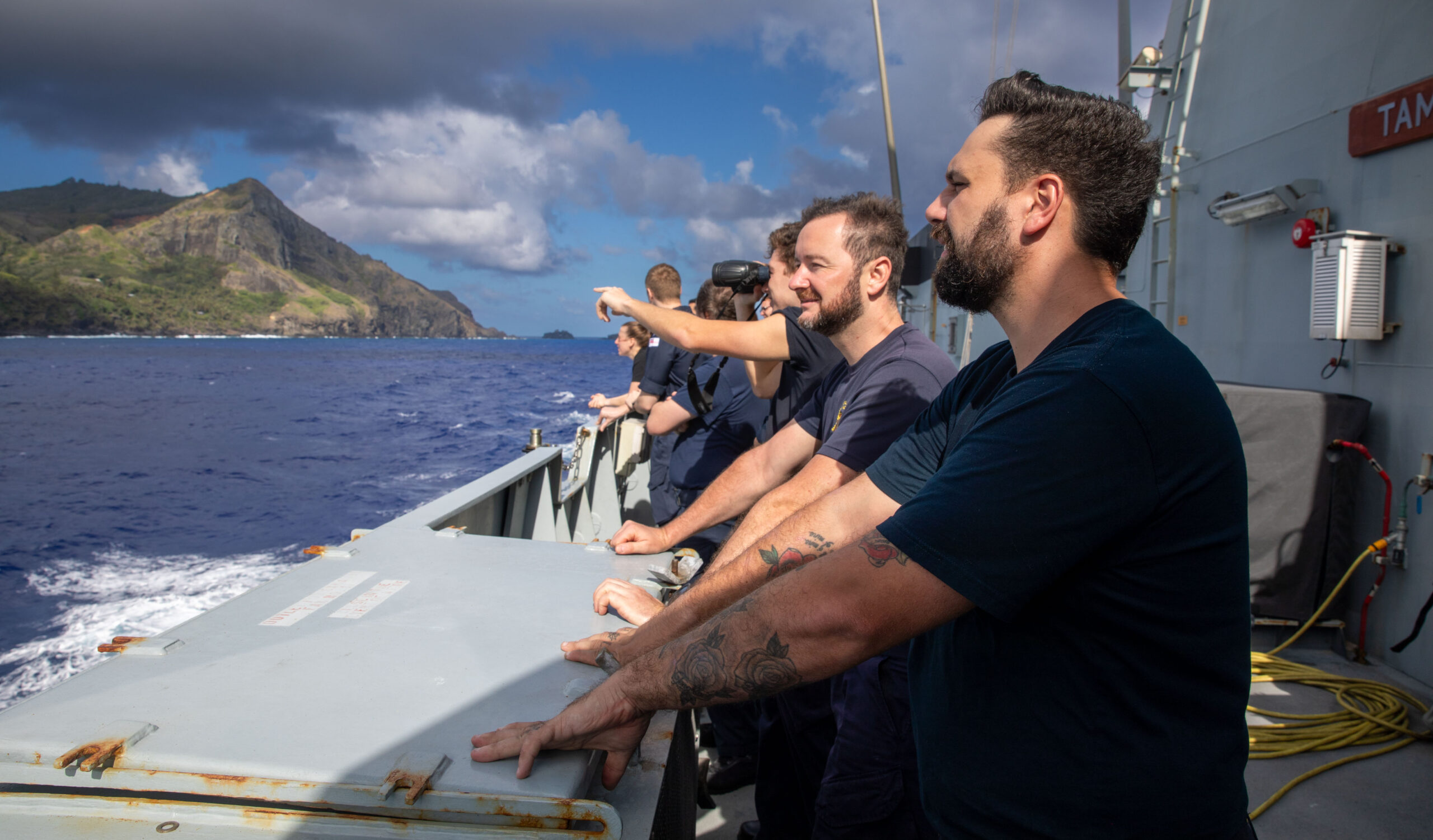Thunder shook paradise as the Royal Navy helped protect the environment of one of the most isolated islands on the planet the Pitcairn islanders.
Patrol ship HMS Tamar spent five days in and around the tiny Pacific island of Pitcairn – famous the world over as the destination of the mutineers of HMS Bounty.
Some 235 years later, the island – at 2.8 square miles it’s roughly the same size as Lundy or Lindisfarne – remains inhabited by the descendants of Bounty’s crew and is a wildlife haven the 40 islanders are determined to protect.
Specialists from Tamar carried out the first stage of neutralising old explosives left on Pitcairn for nearly half a century by carrying out a series of controlled explosions.
The ship conducted sovereignty patrols in the island chain’s waters – the fourth largest Marine Protected Area in the world, covering an area the size of Scandinavia – and gathered water samples for scientists to analyse the impact of climate change.
Pitcairn lies 1,350 miles from Tahiti more than 3,000 miles from New Zealand and 9,000 miles from Tamar’s home base of Portsmouth but is a UK Overseas Territory with a Governor based in Wellington, New Zealand.
Of the four islands, Pitcairn is the only inhabited island and has recently opened a marine science base to investigate the impact of climate change and the health of marine bio-diversity in what is one of the last remaining fully intact marine eco-systems left on the planet.
The arrival of HMS Tamar effectively doubled the Pitcairn population overnight and the sailors immediately knuckled down to community tasks in and around the sole settlement, Adamstown.
Tamar embarked two experts from the Royal Navy’s Portsmouth-based Diving and Threat Exploitation Group to deal with decades-old explosives.
They found more than 1,100 detonators and over three kilometres of detonating cord, left over from construction of the island’s small harbour in the 1970s, which was in a dangerous state and needed disposing; that was carried out with controlled explosions in a sheltered bay.
The explosive experts also found around three and a half tonnes of high explosive ammonium nitrate fuel oil, once used during quarrying mining operations on Pitcairn. A specialist team will return to the island in due course to render it safe.
Elsewhere, sailors helped provide muscle to help with the ongoing construction of Pitcairn’s new community centre, offered advice on maritime infrastructure and the boats used to ferry stores between visiting supply ships and the harbour.
“The islanders were immensely grateful for the support we provided, whether it be advice on their maritime infrastructure; outreach support for the development of their community centre; or ordnance disposal,” said Officer of the Watch Lieutenant Leo Jeune.
“It was a pleasure to meet and integrate with the community, and understand the challenges and unique aspects to living in the UK’s most distant overseas territory, and, one of the most isolated communities in the world.
“Their friendliness and island spirit were mimetic of the communities we often miss when forward deployed away from our homes.”
All Tamar’s crew were invited to a banquet in the main square – and invited roughly half the island’s inhabitants aboard their ship for lunch to thank them for their hospitality.
“It has been a childhood dream to visit the Pitcairn islands. From reading the books to watching films of Fletcher Christian – one of the most infamous mutineers in Royal Naval history – this place has become something of a legend,” said marine engineer Chief Petty Officer Alex Duff.
“To think we anchored in Bounty Bay was amazing enough. We watched Mel Gibson’s Bounty film on the flight deck that evening, in view of the cliffs they would have seen when they made land. That set the tone for what was one of the most unique and interesting visits in my naval career.”
Able Seaman Robert Stevenson added: “It was an amazing experience visiting and supporting the community at Pitcairn.
“I was amazed at how resilient they were, able to sustain themselves so far from normal infrastructure and civilisation. They were so appreciative of the support we gave, and in return showed us some of the most beautifully conserved natural environments I have ever seen.”
The ship’s visit to Pitcairn concluded with a fishery protection patrol which included water sampling and a link-up with the expeditionary cruise ship MS Island Sky which carries adventurous-minded tourists around the South Pacific.
Tamar’s Commanding Officer Commander Tom Gell gave passengers and crew an insight into the patrol ship’s role as well as work in Pitcairn over the radio.
This was the second visit by the Royal Navy in two years to the islands (HMS Tamar’s sister ship HMS Spey delivered Covid vaccines in 2022).
“It was a privilege to visit and support one of the UK’s most distant overseas territories and provide support to maritime security,” said Commander Gell.
“The welcome received by my ship’s company was exceptional, and we were well hosted in return for offering community outreach and support to Explosive Ordnance Disposal.
“It is testament to the UK’s Indo-Pacific tilt and Royal Navy’s Forward Presence programme that HMS Tamar is able to follow in the footsteps of HMS Spey by making a second visit in as many years to the Pitcairn Islands, demonstrating our support for the community and commitment to maritime security in the region.”




